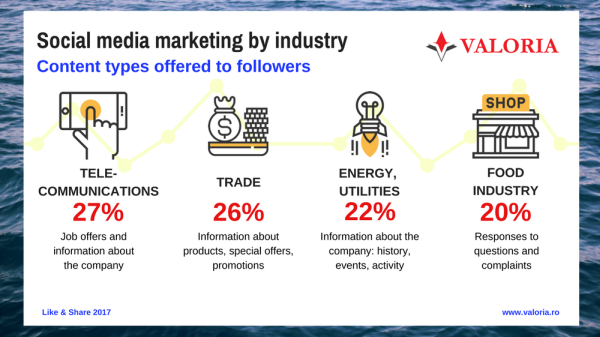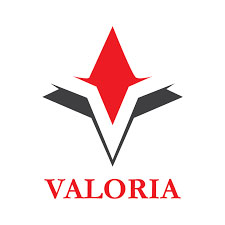In order to better understand how social media marketing evolves, we must how it is used by the different industries and sectors of activity to overcome complex challenges.
According to the Like & Share 2017 study, a social media marketing survey by companies in Romania by Valoria, 80% of companies recognize the effectiveness of social networking marketing. Also, 63% say that social media is an effective channel for creating sales opportunities, but only 3 out of 10 companies use social media for sales.

So, what are the industry-wide differences identified by this study from the answers of the 339 respondents in 14 industries, including 16% CEOs/ Presidents/General Managers and 70% Marketing Directors/Managers/Specialists.
1. Activities on social networks
Marketing ranks first in social media activities for companies in the following industries: industrial production (27%), banking and financial services (24%), and food industry (21%). Competitive analysis is important in the following industries: telecommunications/IT (15%), tourism (12%), energy and utilities (10%). Customer relations through social networking is a priority for the food industry (17%), constructions/real estate (15%), trade (13%), as well as in the banking and financial services industry (13%). The sales-generation through social media is best represented in trade (19%), banking and financial services (11%), media and advertising services (11%).
2. Types of content offered to followers
The content most often provided to followers by tourism companies is special offers and promotions (27%). Telecom companies post business information (e.g. company history, events, initiatives) and available jobs (27%). Those in the banking and financial industry mainly provide information on their products and services (23%), same as those in the pharmaceutical industry (29%), construction (29%) and industrial production (33%).
3. Budget allocated for social media marketing
Most companies in retail and wholesale commerce (31%) have budgets of EUR 1,000-3,000/year for social media marketing, as well as the companies in the food industry (30%). Budgets between EUR 5,000-10,000/year appear in most companies in tourism (25%) and industrial production (24%). The companies in media and advertising (33%), telecommunications and IT (30%) and financial-banking services (29%) have the largest social media marketing budgets, over EUR 10,000/year.
4. The benefits of social media marketing
Each industry has a different mix of benefits that companies extract from social media marketing. Increased exposure to the market is best represented in tourism (22%), construction/real estate (21%) and media and advertising services (20%). In energy and utilities, the number one benefit is to increase the company's reputation (15%) and improve communication with employees (15%). The increase in sales, as a benefit of marketing on social networks, is best represented in the industrial production sector (12%) and customer loyalty in the food industry (18%).
5. Stage in the sales process influenced by social media marketing
In the industrial production sector, companies use the most social media for post-sale assistance, as well as to send periodic news and for prospecting/identifying sales opportunities. It's the same thing in the food industry. For commercial, construction and real estate companies, bidding is the most important stage in the sales process influenced by social media marketing.
The results of the Like & Share 2017 study show that companies in the analyzed industries use social media marketing quite differently. We see extroverted industries that use heavily social media for marketing and communication (financial-banking services, commerce, tourism) as well as introverted industries that use far less the social media platforms (e.g. energy/utilities, pharmaceutical/healthcare).
Simple activities such as responding to comments and private messages lead to customer-centric relationships that are essential to companies. Attachment to brand values ??and consumer loyalty are achieved through customization, responsiveness and excellent management of the relationship with clients. The difference in focus, approach, context, resource, expertise, industry, expertise and expertise of the analyzed industries is pregnant, but only those industries who will innovate and continually update their way of communicating on social networks will enjoy their huge business potential.






























